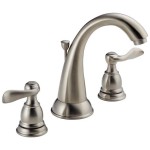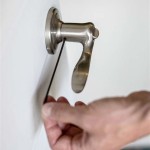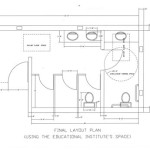How To Clean The Overflow In A Bathroom Sink
The overflow drain in a bathroom sink is a small, often overlooked opening designed to prevent the sink from overflowing. This feature is crucial for maintaining bathroom hygiene and preventing potential water damage. Over time, however, the overflow drain can accumulate grime, soap scum, hair, and other debris, fostering bacteria growth and emitting unpleasant odors. Neglecting this area can lead to hygiene concerns and impede the drainage system's overall efficiency. Therefore, regular cleaning is essential to ensure proper function and maintain a sanitary bathroom environment.
This article provides a comprehensive guide for effectively cleaning the overflow drain in a bathroom sink. It outlines various methods, tools, and solutions that can be employed to remove buildup and eliminate odors. Prioritizing the cleaning of this seemingly minor component can contribute significantly to the overall cleanliness and hygiene of a bathroom.
Understanding the Overflow Drain
The overflow drain is typically located just below the rim of the sink basin. Its primary function is to provide an escape route for water when the sink reaches its maximum capacity. This prevents spillage onto the bathroom floor, minimizing the risk of water damage and potential slipping hazards. In addition to preventing overflows, it also helps to equalize air pressure within the drainpipe, facilitating smoother drainage. The design usually consists of a small opening connected to a channel that leads down to the main drainpipe. The complexity of the design often leads to trapped debris and stagnant water, creating a breeding ground for bacteria and mold.
The accumulation within the overflow drain is a common issue due to the environment's nature. The constant exposure to water, soap residue, and shed hair makes it a prime location for buildup. Furthermore, the dark and damp conditions inside the drain channel promote the growth of unwanted microorganisms. This buildup can lead to slow draining, foul odors, and even potential plumbing problems if left unattended. Regular maintenance is necessary to prevent these issues and ensure the drain functions as intended.
Identifying the type of sink and overflow drain construction can be beneficial when selecting the appropriate cleaning method. Some overflows are directly connected to the drainpipe, while others have a more convoluted path. Recognizing this can help determine the best approach for accessing and thoroughly cleaning the area. Familiarizing oneself with the sink's specific design can prevent potential damage and ensure a more effective cleaning process.
Cleaning Methods and Solutions
Several methods can be used to clean the overflow drain, each with its own set of advantages and disadvantages. The choice of method should depend on the severity of the buildup, the accessibility of the drain, and the materials available. The following sections outline some of the most effective cleaning techniques.
Hot Water Flush: This is the simplest and often the first method to try. Running hot water down the overflow drain can help loosen and dislodge some of the accumulated debris. For this method, the sink stopper must be in the open position to allow the flushed debris to flow freely down the drainpipe. The water temperature should be as hot as safely possible without causing burns or damage to the sink material. Run the hot water for several minutes to ensure a thorough flush. Repeat this process periodically as a preventative measure.
Baking Soda and Vinegar: This is a popular and effective natural cleaning solution. Combine approximately one cup of baking soda with one cup of vinegar. The mixture will create a fizzing reaction, which helps to break down grime and neutralize odors. Pour the mixture directly into the overflow drain and allow it to sit for at least 30 minutes, or preferably overnight, for optimal results. Afterward, flush the drain with hot water to remove any remaining residue. This method is particularly effective for breaking down soap scum and eliminating mild odors.
Wire Brush or Pipe Cleaner: For more stubborn buildup, a small wire brush or pipe cleaner can be used to manually scrub the inside of the overflow drain. Gently insert the brush or cleaner into the drain opening and scrub the interior walls. This method is effective for dislodging larger pieces of debris and reaching areas that are difficult to access with liquid solutions. Be careful not to apply excessive force, as this could potentially damage the drain lining. After scrubbing, flush the drain with hot water to remove dislodged particles.
Bleach Solution: A diluted bleach solution can be used to disinfect the overflow drain and kill bacteria. Mix one part bleach with ten parts water. Carefully pour the solution into the overflow drain, ensuring that it comes into contact with all interior surfaces. Allow the solution to sit for approximately 15-20 minutes, then thoroughly flush the drain with cold water. Exercise caution when using bleach, as it can irritate skin and eyes. Ensure adequate ventilation during the cleaning process and wear gloves to protect your hands. This method is effective for eliminating stubborn odors and killing bacteria but should be used sparingly due to its corrosive nature.
Specialized Drain Cleaners: Several commercially available drain cleaners are specifically designed for clearing clogged drains. These products often contain enzymes or chemicals that break down organic matter and dissolve buildup. Follow the manufacturer's instructions carefully when using these cleaners. Some drain cleaners can be corrosive and may damage certain types of pipes or sink materials. It is important to select a drain cleaner that is safe for the type of plumbing system in the bathroom. Always wear gloves and eye protection when handling these products.
Pressurized Water: Using a syringe or a small hose attached to a water source, pressurized water can be directed into the overflow drain to dislodge stubborn blockages. This method is especially useful for flushing out debris that is lodged deep within the drain channel. Be careful not to apply excessive pressure, as this could damage the sink or plumbing. Direct the water stream strategically to target areas of buildup and flush out the drain thoroughly.
Preventative Measures and Maintenance
Regular maintenance is key to preventing buildup and keeping the overflow drain clean. Incorporating a few simple habits into the bathroom cleaning routine can significantly reduce the frequency and intensity of cleaning required. These preventative measures will also prolong the life of the plumbing system and contribute to a healthier bathroom environment.
Regular Flushing: Periodically flushing the overflow drain with hot water can help prevent the accumulation of debris. Make it a habit to run hot water down the drain at least once a week, especially after activities that generate soap scum or hair. This simple practice will help keep the drain clear and prevent particles from solidifying.
Strainer Use: Using a strainer in the sink drain can trap hair and other debris before they enter the plumbing system. This significantly reduces the amount of material that accumulates in the overflow drain and the main drainpipe. Empty the strainer regularly to prevent buildup and maintain its effectiveness. Various types of strainers are available, ranging from simple mesh screens to more elaborate designs that catch even the smallest particles.
Baking Soda and Vinegar Maintenance: Periodically using the baking soda and vinegar mixture as a preventative measure can help keep the overflow drain clean and odor-free. Repeat this process every few weeks to maintain a clear drain and prevent the buildup of soap scum and grime. This natural cleaning method is a safe and effective way to keep the plumbing system in good condition.
Proper Ventilation: Ensuring proper ventilation in the bathroom can help reduce moisture levels and prevent the growth of mold and bacteria in the overflow drain. Use the exhaust fan during and after showers and baths to remove excess humidity. This will create a less favorable environment for microbial growth and help keep the drain clean and fresh.
Avoid Harsh Chemicals: While chemical drain cleaners can be effective for clearing clogs, excessive use can damage pipes and contribute to buildup over time. Avoid using harsh chemicals on a regular basis and opt for natural cleaning methods whenever possible. Harsh chemicals can corrode pipes, leading to leaks and other plumbing problems. When using chemical drain cleaners, follow the manufacturer’s instructions carefully and use them sparingly.
Professional Inspection: Schedule a professional plumbing inspection at least once a year to identify and address any potential issues with the plumbing system. A plumber can inspect the overflow drain and other drainage components to ensure they are functioning properly and free of buildup. Regular inspections can help prevent costly repairs and maintain the overall health of the plumbing system.
By implementing these cleaning methods and preventative measures, one can maintain a clean and functional overflow drain in a bathroom sink. Regular maintenance not only promotes hygiene but also extends the lifespan of the plumbing system, ultimately contributing to a more comfortable and sanitary bathroom environment.

Function And Cleaning Of A Sink Overflow Hole Merry Maids

How To Clean Sink Overflow Drain

How Do I Clean The Overflow Hole In My Sink

Waterdrills Sink Overflow Demo

Think Twice Before Using Tiktok S Shaving Cream To Clean Your Sink Drain

Sink Overflow Cleaning S Maid To Please

How Do I Clean The Overflow Hole In My Sink

How To Clean A Sink Overflow Drain

How To Clean Sink Overflow Drain

Tips On How To Clean Sink Overflow Clover Contracting
Related Posts







